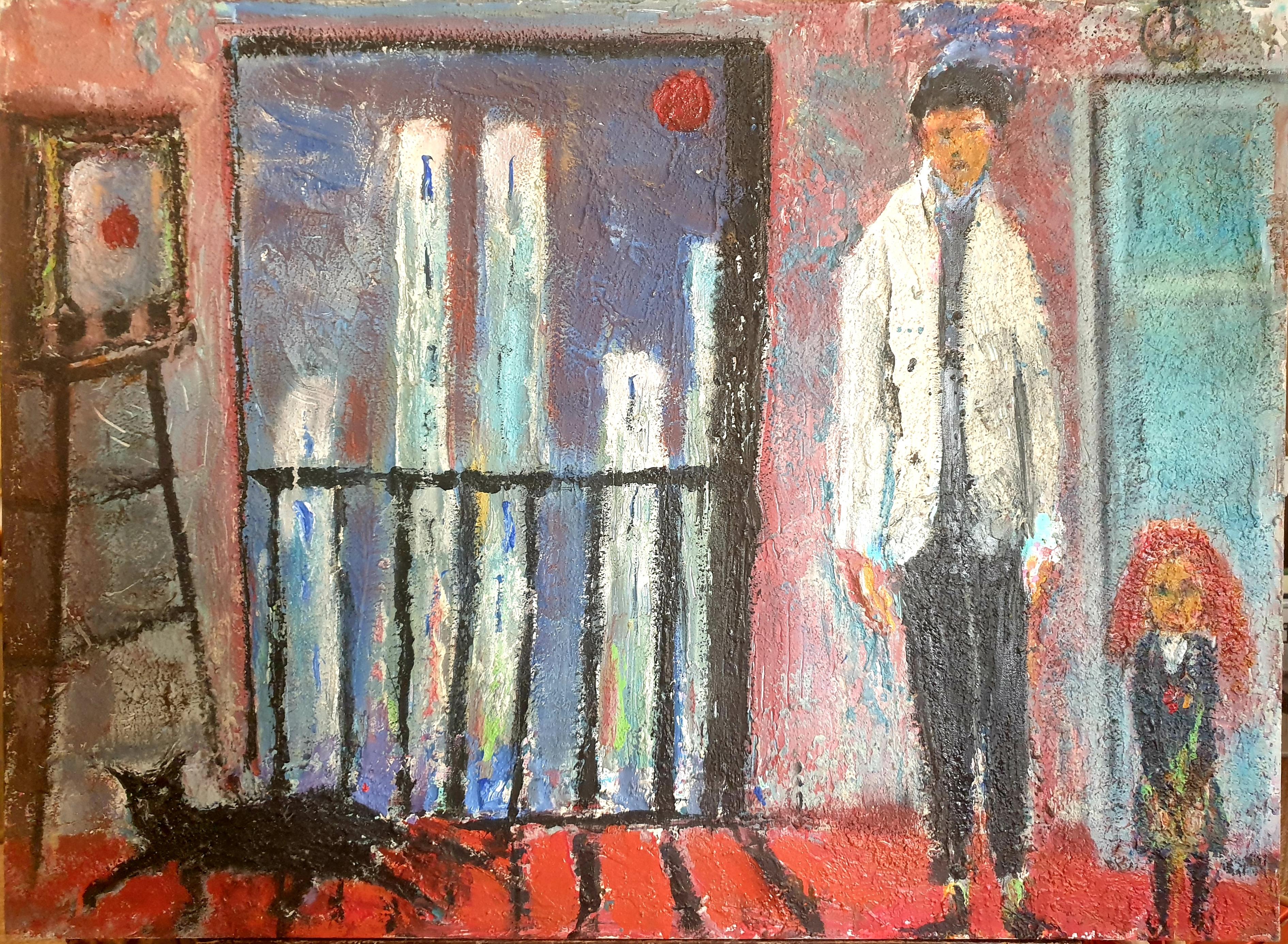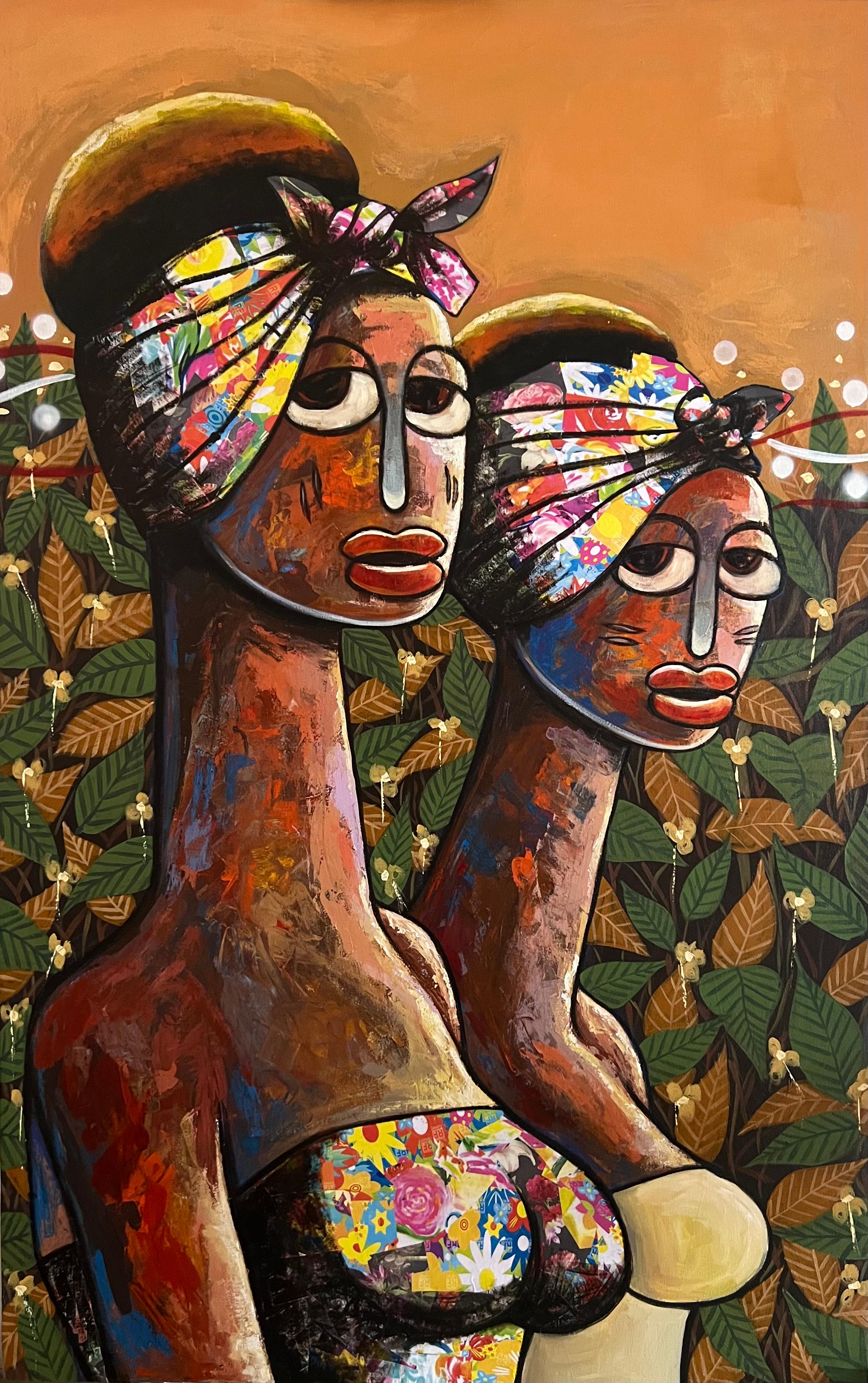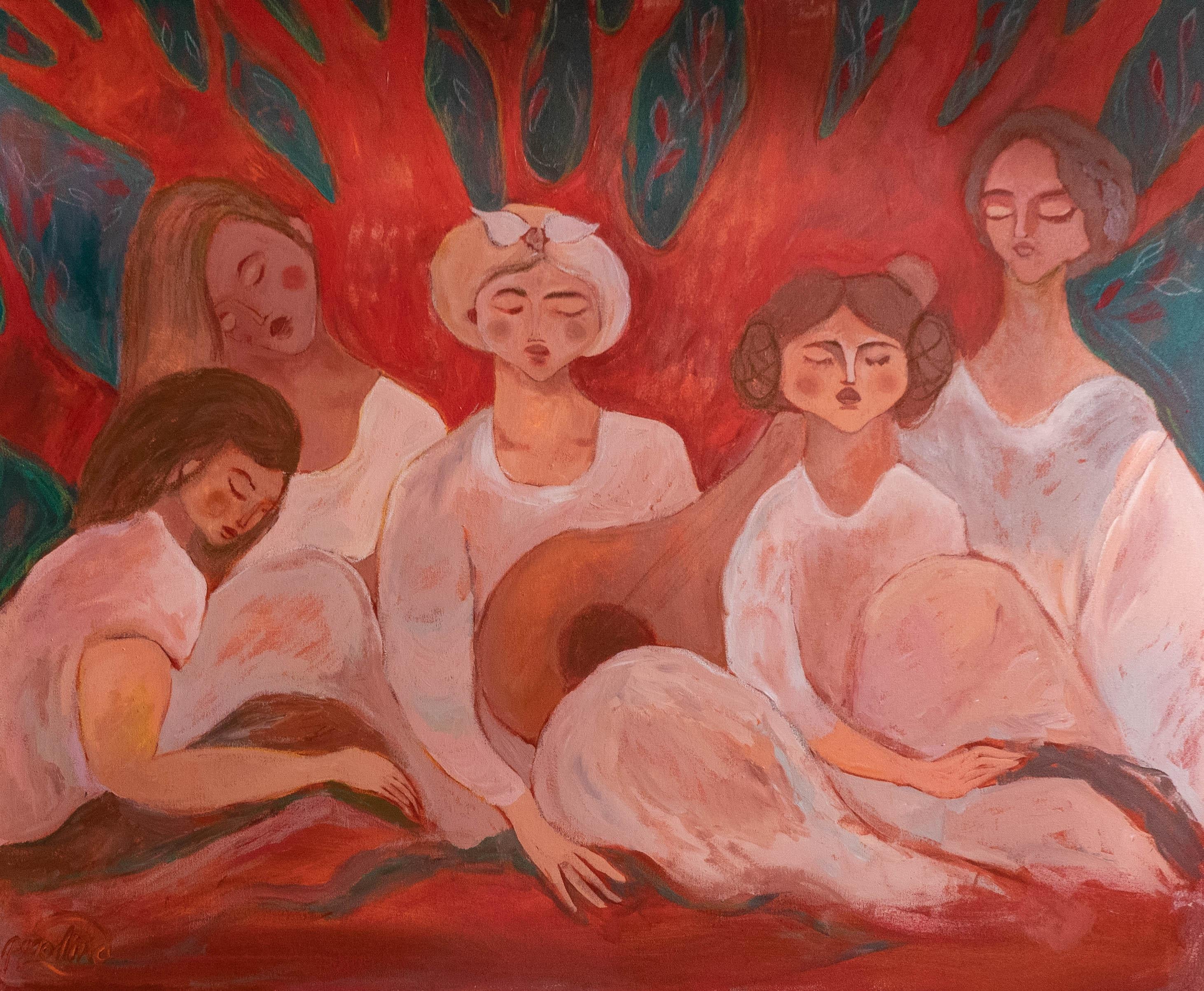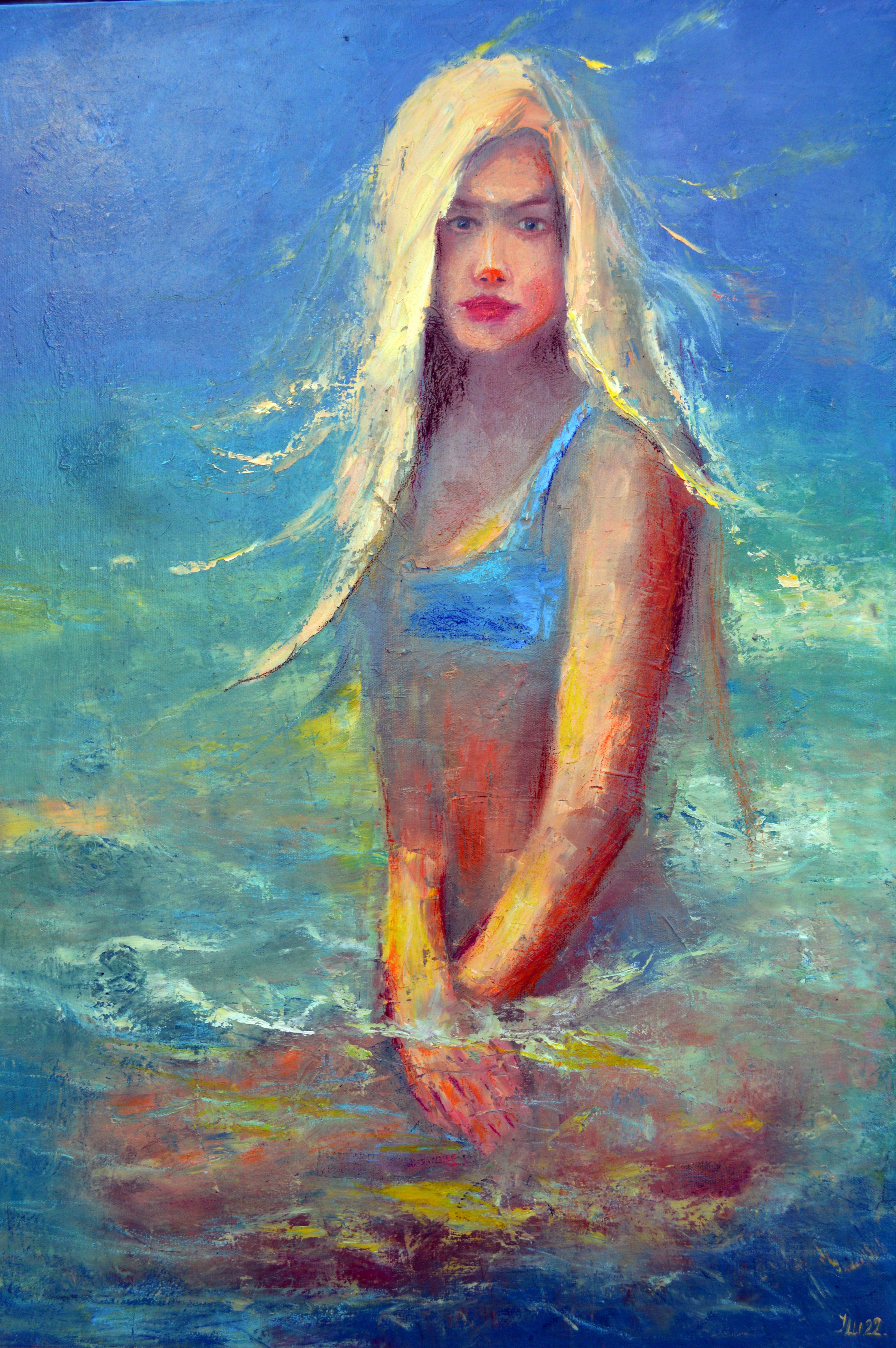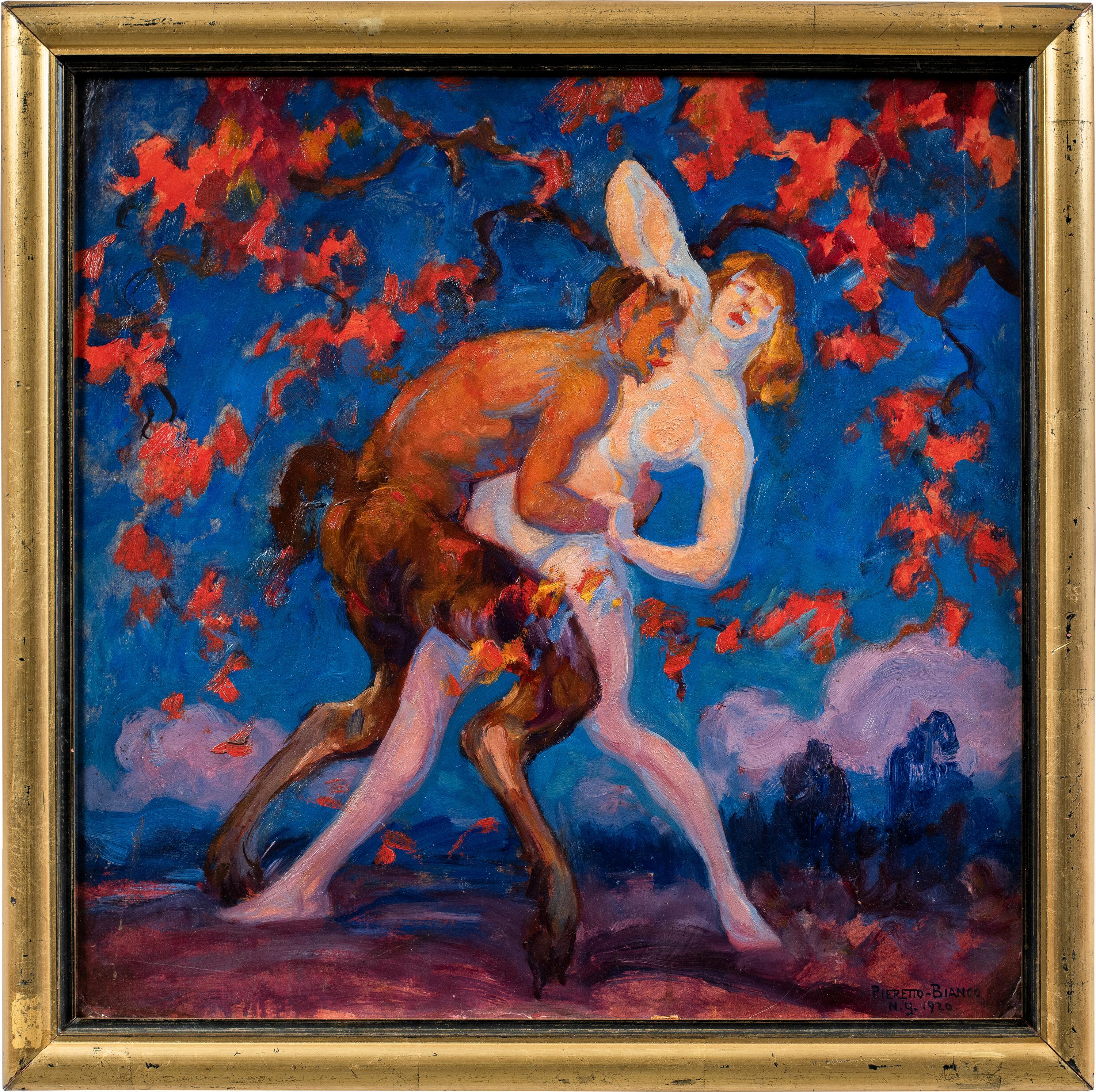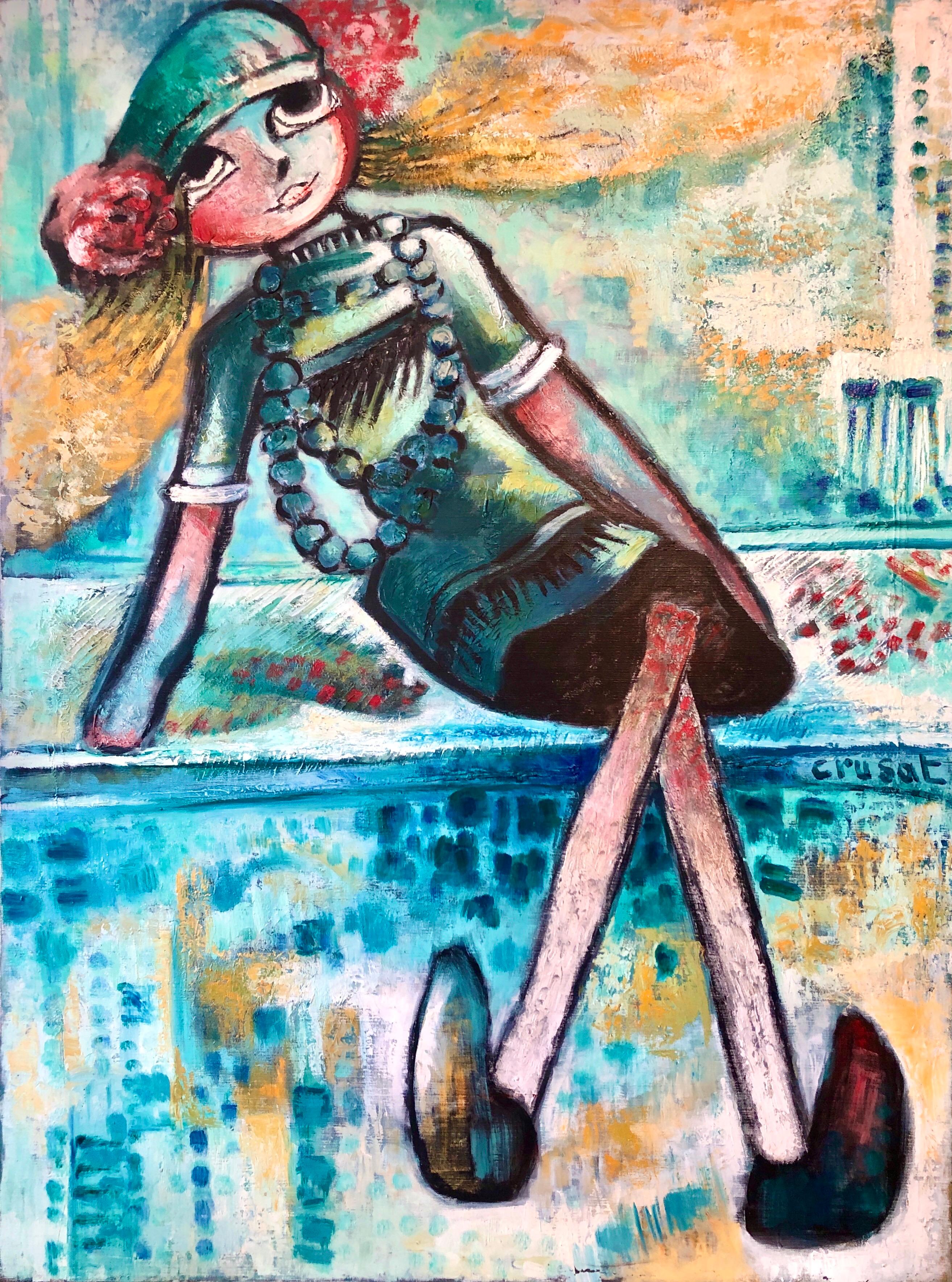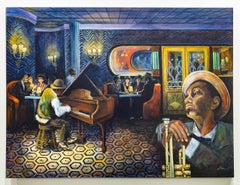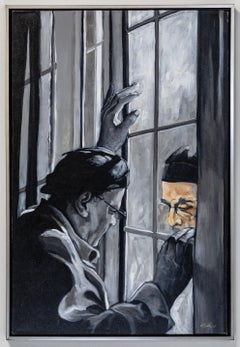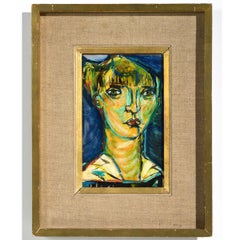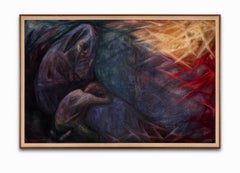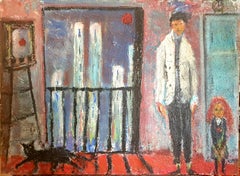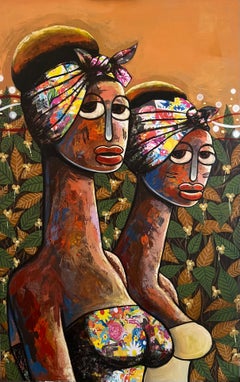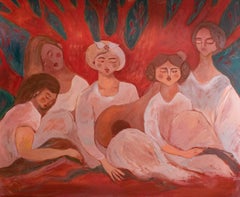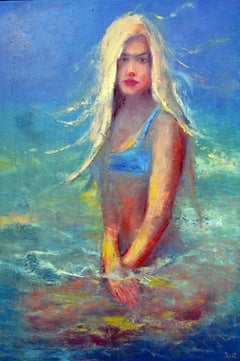Items Similar to "The Card Players" Interior Scene, Card Players, African-American, Intense Color
Want more images or videos?
Request additional images or videos from the seller
1 of 8
Alvin Demar Loving"The Card Players" Interior Scene, Card Players, African-American, Intense Color1959
1959
About the Item
"The Card Players" is an extraordinarily rare and early painting of Alvin Demar Loving, a major artist in the lexicon of 20th century African-American artists. This piece has just recently been on the market from his brother Paul Loving and would be a significant addition to any African-American collection privately held or in a public museum. Mr. Loving created this piece while a student at University of Michigan , Ann Arbor, Michigan.
The artist intended to join fellow Fraternity members at a poker game at Omega Phi in Detroit, but upon arriving at the Fraternity House, was so struck by the interior night scene, he immediately returned to his studio to commit the vision to canvas. Some of the players are back lite with intent to give a dramatic atmosphere to the seemingly quiet room. Loving uses paint colors with extreme skill and this painting is a perfect example with patches of golden, cadmium orange and burnt umber. Al Loving's favorite swirl motif can be seen in the arabesque design of the overhead chandelier. He uses this motif with a "Joie de Vivre" in many of his later abstract mixed media works. "The Card Players" is reminiscent of Paul Cezanne's "The Card Players", but the similarities stop with the subject matter. Loving moves away from Cezanne's staged set, to a dramatic composition full of color and life. This piece has been completely restored with great care by Kenneth Katz, Fellow of the International Institute of Conservation. Loving originally signed the stretcher which has been completely replaced during restoration. The portion with his signature is attached to the new stretcher (old stretcher has been retained and can be shipped with artwork.).
In the 1960s, Loving grew increasingly interested in Josef Albers's paintings of squares within squares. In an interview, he explained: "For me at the time, it was about painting the square until it was 'enough,' and that meant until it obtained form. The square that I started with would always be gone; only I knew it was a square, that reference was there. That freed me to just paint and let things evolve. The square was pure energy and focus.” These geometric abstractions conveyed the brilliance of refracted light; they were not just experiments in color.
Loving would often make polyhedrons of the same size, with different colors, and hang them together in different arrangements on the wall. The result was sometimes dozens of canvases stretching out over several feet; to view an entire composition would take time, more than just a glance, making his paintings a powerful expression of time, too. Loving's geometric paintings were featured in his first solo exhibition at the Whitney Museum of American Art. Loving later abandoned hard-edged abstraction painting.
After completing his MFA at the University of Michigan in 1968 Loving moved to New York City to the infamous Chelsea Hotel that was the home of numerous artists, writers and musicians. Within a year he had his Whitney Solo Exhibition, the first one for an African American artist.
In the 1980s, Loving began to integrate other materials into his constructions, such as corrugated cardboard and rag paper. Loving quickly took a liking to the casualness of tearing cardboard and gluing it onto other pieces; in fact, he considered this practice abstract expressionist as well. The large paper collages gave him a sense of freedom because he was trekking through uncharted territory (although this work has been likened to Frank Stella's curvilinear metal reliefs and Elizabeth Murray's shaped canvases). Loving integrated circles and spirals into these collages as a nod to his African roots and as an expression of growth and continued life. In the piece Perpetual Motion (1994) (DASNY) Loving integrated materials such as cardboard and print. The cardboard is cut and overlapped to form a series of spirals. Each spiral has been carefully painted and placed to create dynamic color relationships. They do not have conventional matting under them, glass to cover them or frames to surround them: instead they cling flatly to the wall. Sandra Yolles, reviewing an exhibition in 1990, explained "Loving’s work is about earth, wind, fire, and water: some pieces might be considered atmospheric maps of life at full blast—stretching the possibilities of the human spirit by delineating its directions, currents, and eddies.'”
Loving received National Endowment for the Arts fellowships in 1970, 1974, and 1984 and was awarded a Guggenheim Fellowship in 1986.
Loving created large-scale commissioned public works throughout his career for The First National Bank Building in Detroit, MI, for the Empire State Collection in Albany, NY, a ceramic mural in one of Detroit's People Mover stations, and another in the Library at Wayne State University. In 1996, he created a collage painting Sacramento New Morning for the Sacramento Convention Center, and in 2001 he designed 70 stained-glass windows and mosaic walls for the Broadway Junction subway in Brooklyn.
- Creator:Alvin Demar Loving (1935 - 2005)
- Creation Year:1959
- Dimensions:Height: 50 in (127 cm)Width: 60 in (152.4 cm)
- Medium:
- Movement & Style:
- Period:
- Condition:Normal paint crackling. Restoration: Removed grime 5% T.A.C., distilled water, patched tears, left sewn artist's patch, strip lined: Beva Sheet Film & Pecap. Restretched on to Simon Liu stretcher, filled losses, inpainted filled: wax & Maimeri colors.
- Gallery Location:Detroit, MI
- Reference Number:1stDibs: LU128616229582
About the Seller
5.0
Vetted Professional Seller
Every seller passes strict standards for authenticity and reliability
Established in 2014
1stDibs seller since 2019
106 sales on 1stDibs
Typical response time: 1 to 2 days
- ShippingRetrieving quote...Shipping from: Detroit, MI
- Return Policy
Authenticity Guarantee
In the unlikely event there’s an issue with an item’s authenticity, contact us within 1 year for a full refund. DetailsMoney-Back Guarantee
If your item is not as described, is damaged in transit, or does not arrive, contact us within 7 days for a full refund. Details24-Hour Cancellation
You have a 24-hour grace period in which to reconsider your purchase, with no questions asked.Vetted Professional Sellers
Our world-class sellers must adhere to strict standards for service and quality, maintaining the integrity of our listings.Price-Match Guarantee
If you find that a seller listed the same item for a lower price elsewhere, we’ll match it.Trusted Global Delivery
Our best-in-class carrier network provides specialized shipping options worldwide, including custom delivery.More From This Seller
View All"The Weary Blues" Acrylic Painting of Interior w/Patrons and Music Colorful
By Dennis K. Smith
Located in Detroit, MI
"The Weary Blues" depicts the interior scene of a Blues bar late at night with a number of patrons socializing, drinking and listening to music. The scene is dramatically rendered in...
Category
2010s Contemporary Figurative Paintings
Materials
Canvas, Acrylic
"I See Color" Figurative Acrylic on Canvas Looking Out Window Black White Color
By Dennis K. Smith
Located in Detroit, MI
"I See Color" is a dramatic psychological study of personal discovery painted in black and white with the face reflected on a window painted in color. Dennis states: It was a time wh...
Category
Early 2000s Contemporary Figurative Paintings
Materials
Canvas, Acrylic
Michael Patrix Oil Painting "Head of Woman"
Located in Detroit, MI
"Head of Woman" is a wonderfully exciting example of Mid-20th century Expressionist art. This vibrant portrait is reminiscent of Matisse's Fauvist female...
Category
Mid-20th Century Expressionist Figurative Paintings
Materials
Canvas, Oil
Fanny Rabel Figurative Oil Painting Soulful, Prayerful
By Fanny Rabel
Located in Detroit, MI
SALE ONE WEEK ONLY
UNTITLED by Fanny Rabel a Mexican artist who was born in Poland in 1922 is a soul wrenching work depicting among other things, the children killed by Nazi bombing in Spain during the Second World War. The lavender and purple surrounding the seated female figure and the kneeling child suggest both grief for the innocents' deaths and the prayers being offered for an end to the carnage. The bright gold and red can be read as either explosions or the hopeful light of redemption after death. Like Picasso's Guernica from 1937, this painting from 1965 can stand as a powerful anti-war statement.
Numerous key galleries and museums such as Morton Auctions, Cerro de Mayka have featured Fanny Rabel's work in the past. Her anti-Nazi and anti-Fascism politics resulted in her participation in a mural called Retrato de la Burguesía in 1940 for the Sindicato Mexicano de Electricistas building on Alfonso Caso Street in Mexico City. Rabel met a group of exiled Spaniards in Mexico along with Antonio Pujol, who invited her to take part in a mural project headed by him, David Alfaro Siqueiros, Joseph Renau, Luis Arenal, Antonio Rodríguez Luna and Miguel Prieto. The artist died in 2008.
Fanny Rabel born August 27, 1922, in Poland born Fanny Rabinovich, was a Polish-born Mexican artist who is considered to be the first modern female muralist and one of the youngest associated with the Mexican muralism of the early to the mid-20th century. She and her family arrived in Mexico in 1938 from Europe and she studied art at the Escuela Nacional de Pintura, Escultura y Grabado "La Esmeralda", where she met and became friends with Frida Kahlo. She became the only female member of “Los Fridos” a group of students under Kahlo’s tutelage. She also worked as an assistant and apprentice to Diego Rivera and David Alfaro Siqueiros, painting several murals of her own during her career. The most significant of these is "Ronda en el tiempo" at the Museo Nacional de Antropología in Mexico City. She also created canvases and other works, with children often featured in her work, and was one of the first of her generation to work with ecological themes in a series of works begun in 1979.
She is considered to be the first female muralist in Mexico. She was an assistant to Diego Rivera while he worked on the frescos for the National Palace and an apprentice to David Alfaro Siqueiros. Her most important mural is Ronda en el tiempo located in the Museo Nacional de Antropología, which was created from 1964 to 1965. She also created murals at the Unidad de Lavaderos Público de Tepalcatitlán (1945), Sobrevivencia, Alfabetización in Coyoacán in 1952 Sobrevivencia de un pueblo at the Centro Deportivo Israelita (1957) Hacia la salud for the Hospital Infantil de México (1982), La familia mexicana at the Registro Público de la Propiedad (1984) (which Rabel preferred to title Abolición de la propiedad privada) and at the Imprenta Artgraf. In collaboration with other artists, she participated in the creation of the murals at the La Rosita pulque bar (disappeared) and at the Casa de la Madre Soltera.
She entered the Escuela Nacional de Pintura, Escultura y Grabado "La Esmeralda" shortly after it was established in 1942, taking classes with José Chávez Morado, Feliciano Peña and Frida Kahlo, with whom she became close friends. She changed her last name from Rabinovich to Rabel during her career.
Rabel married urologist Jaime Woolrich and had two children Abel and Paloma Woolrich, both of whom became actors. The first exhibition of her work was in 1945 with twenty-four oils, thirteen drawings, and eight engravings at the Liga Popular Israelita with Frida Kahlo writing the presentation. In 1955, she had an individual exhibition at the Salón de la Plástica Mexicana. She had a large exhibition at the Museum of the Palacio de Bellas Artes to commemorate a half-century of her work. Her last exhibition was in 2007 at the Universidad Autónoma Metropolitana. Her work can be found in collections in over fifteen countries including those of the New York Public Library, the Library of Congress in Washington, D.C., the Royal Academy of Denmark, the National Library in Paris, the Casa de las Américas in Havana, the Benemérita Universidad Autónoma de Puebla and the Museo de Arte Moderno in Mexico City.
A retrospective of her work after her death called Retrospectiva in Memoriam, Fanny Rabel (1922-2008) was held at the Museum of the Universidad Popular Autónoma del Estado de Puebla . She is considered to be the first modern female muralist in Mexico although she also did significant work in painting, engraving, drawing, and ceramic sculpture. Her work has been classified as poetic Surrealism, Neo-expressionism and is also considered part of the Escuela Mexicana de Pintura (the dominant art movement of the early to mid 20th century in Mexico) as one of the youngest muralists to be associated with it along with Arnold Belkin and José Hernández Delga.
Rabel was more drawn to depicting mankind’s pain rather than happiness, sharing other Mexican muralists' concerns about social injustice. However, she stated to Leopoldo Méndez that she could not create combative works, with clenched fists and fierce faces, and she wanted to leave the Taller de Gráfica Popular. Méndez convinced her to stay, saying that more tender images are important to political struggle as well. Children with Mexican faces...
Category
1960s Expressionist Figurative Paintings
Materials
Oil, Canvas
"Untitled Female"
By Richard Wilson
Located in Detroit, MI
“Untitled Female" is a colorful piece by Richard Wilson that has meaning for native Detroiters through use of the blues and oranges - their "Tiger" baseball team's colors and the "D"...
Category
2010s Expressionist Figurative Paintings
Materials
Canvas, Acrylic
"Untitled Female" Clothed Female Figure, Bright Colors, Detroit Symbols
By Richard Wilson
Located in Detroit, MI
“Untitled Female" is a colorful piece by Richard Wilson that has meaning for native Detroiters through use of the blues and oranges - their "Tiger" baseball team's colors and the "D"...
Category
2010s Expressionist Figurative Paintings
Materials
Canvas, Acrylic
You May Also Like
Large Expressionist Oil on Canvas, Apartment Interior and Cityscape. Oil.
By Ernst Ludwig Kirchner
Located in Cotignac, FR
A mid century Expressionist oil on canvas of a man, child and cat in an interior with a cityscape beyond. The work is not signed but there are various notations to the top rear stret...
Category
Mid-20th Century Expressionist Figurative Paintings
Materials
Canvas, Oil
Maiden - 21st Century, Contemporary, Figurative. Neo-Expressionism, Women, Faces
Located in Ibadan, Oyo
Shipping Procedure
Ships in a well-protected tube from Nigeria
This work is unique, not a print or other type of copy.
Accompanied by a Certificate of Authenticity (Issued by the Gal...
Category
21st Century and Contemporary Expressionist Figurative Paintings
Materials
Canvas, Mixed Media, Oil, Acrylic
Soulmate Modern Figurative Oil Painting by Ukranian Artist Dasha Pogodina
Located in Zofingen, AG
Participant SOLO EXHIBITION in Thun, Switzerland "Strength, and Vulnerability" December 2022. Please get in touch with us if you have any questions about this artwork.
MATERIALS:
Th...
Category
2010s Expressionist Figurative Paintings
Materials
Canvas, Oil
Summer. Sea. Beach.
Located in Zofingen, AG
In this piece, I immerse the viewer in the depths of a summer atmosphere, where the sea's dynamic caress and the vibrant warmth of sunlight meet. The textures and colors in oil empha...
Category
2010s Expressionist Interior Paintings
Materials
Canvas, Oil
Pieretto Bianco (Italian painter) - Early 20th century figure painting - Satyr
Located in Varmo, IT
Pietro Bianco Bortoluzzi, known as Pieretto Bianco (Trieste 1875 - Bologna 1937) - Satyr and Nymph.
50.5 x 50.5 cm without frame, 57.5 x 57.5 cm with frame.
Oil on cardboard, in a ...
Category
Early 20th Century Expressionist Figurative Paintings
Materials
Canvas, Oil
$2,553 Sale Price
26% Off
Free Shipping
Large French Expressionist Oil Painting, Girl, Poupèe, the Doll, Ecole de Paris
Located in Surfside, FL
Signed on recto and signed verso, titled, and inscribed Montmartre by the artist. This is a large colorful expressionist painting of a girl doll with long blonde or ginger redhead pigtails. It is titled Poupee 1925 and depicts an Art Deco era flapper girl in a beret.
Roger Crusat (French Expressionist artist, poet and lithographer) is known for ballet troupe set design and theatre backdrop painting and architectural motifs. Roger Crusat was born in 1917 in Roussillon, Provence, France. Crusat's early works depict the colorful countryside of Provence in the South of France, As a young man Crusat performed many jobs in the troupe, designing costumes, and even dancing. But, most important, he painted the scenery for the troupe's performances. It was while working in this capacity that he learned the essentials of scenery painting that remain evident in his mature work. Crusat was a student of Andre Fons-Godail at Beaux-Arts in Perpignan when he was called to serve in World War II. After being wounded in 1940, he returned to study under Rene Jaudon at Beaux-Arts in Paris. Crusat was known by his contemporaries as "the Catalan painter of Montmartre" where he lived with his wife until his death in 1994. Cracked and peeling walls framed by rusting water pipes are a common sight in Montmartre. What others considered unnecessary, Crusat included. Water pipes were his cherished motif. Supposed by some to be a symbol of decay and monotony, Crusat's Impressionist water pipes like arteries in the body, convey life. Crusat won the prestigious Prix Populiste for his "Descente d'Eau" (Water Pipes) in 1956.
Crusat's mature work retains the essentials of good scenery painting. Intricate detail will not be found, but broad, solid abstract shapes abound. His subtle colors, dense in texture, are meant to compliment his subjects, not distract from them. The critics considered him a lyric expressionist and a "painter of Man" in his portrayal of the anguish of daily life and the regrets of the past. Crusat exhibited at many of the same Salons as the post-impressionists and expressionists. Salon des Independants was co-founded by Georges Seurat. Degas had only one exhibition during his lifetime, and it was at the Galerie Durand Ruel in Paris. Gauguin had also exhibited his Tahitian paintings. Crusat's works were exhibited there in 1955.
SELECT AWARDS
1954 Le Prix de la Jeune Peintre
1955 Prix des Amateurs d'Art & des Collectionneurs, Galerie Gazette des Beaux Arts, 140 rue
Faubourg St. Honore, Paris Les Jardins des Abbesses purchased by the Republic of
France, Prix de la Ville de Marseilles, Prix Othon Friesz
1956 Prix Populiste, Prix de Amedeo Modigliani
1957 Grand Prix International de Vichy, Prix de la Fondation Greenshields
1959 IVeme Grand Prix de Peinture du Festival de Vichy
1967 Le Prix des Amis de Brantôme, Perigord, France
1970 Prix de la Critique Academy de Vernet a Vichy,"La Nuit, Premiere Etude"
Roger Crusat, Half-closed shutters , poems enriched with four original lithographs (175 numbered copies) drawn on Henri Deprest's presses on February 13, 1975 , Éditions Matignon 34, 1975.
Personal exhibitions
Durand-Ruel Gallery, Paris, 1955 [ 1 ] .
Galerie Rivière, Paris, november 1958 [ 4 ] .
Le Roux and Mathias, auctioneers in Paris, Sale of the Roger Crusat workshop , Hôtel Drouot , Paris, Thursday October 27, 1994 [ 5 ] .
Jack's American Bistro, Glens Falls , September- october 2004 [ 6 ] .
Collective exhibitions
Galerie Roger, Lyon , October 1946 [ 7 ] .
Salon des Indépendants , Paris, from 1952 [ 8 ] .
Exhibition Discover , Galerie Charpentier , Paris, 1955.
Populist Salon, Paris, 1956.
Salon des Amis de Brantôme, 1957.
Hundred painters and oil - Exhibition on the occasion of the centenary of the first oil drilling , Musée Galliera , october 1958 [ 9 ] .
“An artist from Roussillon whose invoice calls for a flattering comparison with that of a Soutine or a Rebeyrolle . Indeed, following their example, he focuses on familiar scenes: Girls on the balcony or in the basket , Laundresses weighing heavily on the iron, draft horses or plucked turkeys, who stand next to a magnificent portrait of a man in a red dressing gown . Hasn't the Prix Populiste already crowned its merits? " - Jean Jacquinot
SELECT EXHIBITIONS
Galerie La Gentilhommiere, Paris
La Salle Arago, Perpignan, Salon des Indépendants, Salon d'Automne
Biennale de Menton, Menton
Galerie des Jacobins, Lyon
Galerie Durand-Ruel, Paris
Salon de la Nationale
Galerie Bassano, Paris
Salon Populiste
Salon de Romans
Galerie Motte, Geneva, Switzerland
Exposition à Quiberville sur Mer - Normandie
Galerie Charpentier
Salon Confrontation: Bernard Buffet, Roger Crusat, Jean Jansem, Franck Innocent...
Category
Mid-20th Century Expressionist Figurative Paintings
Materials
Canvas, Oil
Recently Viewed
View AllMore Ways To Browse
Nude Sculpture Black
Only Under 40
Black And White Photos Of Women
Map Of London
Nature Photography Forest
Book Press Used
San Diego Photography
White Clay Sculptures
Red Etching
American Fold Art
Joan Miro Signed Numbered
German Jewish
Hebrew Art
Lithograph Horses
Vintage Sports Photography
Abstract Woman Sculpture
Prints 20th Century Women Artists
1970s Geometric Abstract Art
